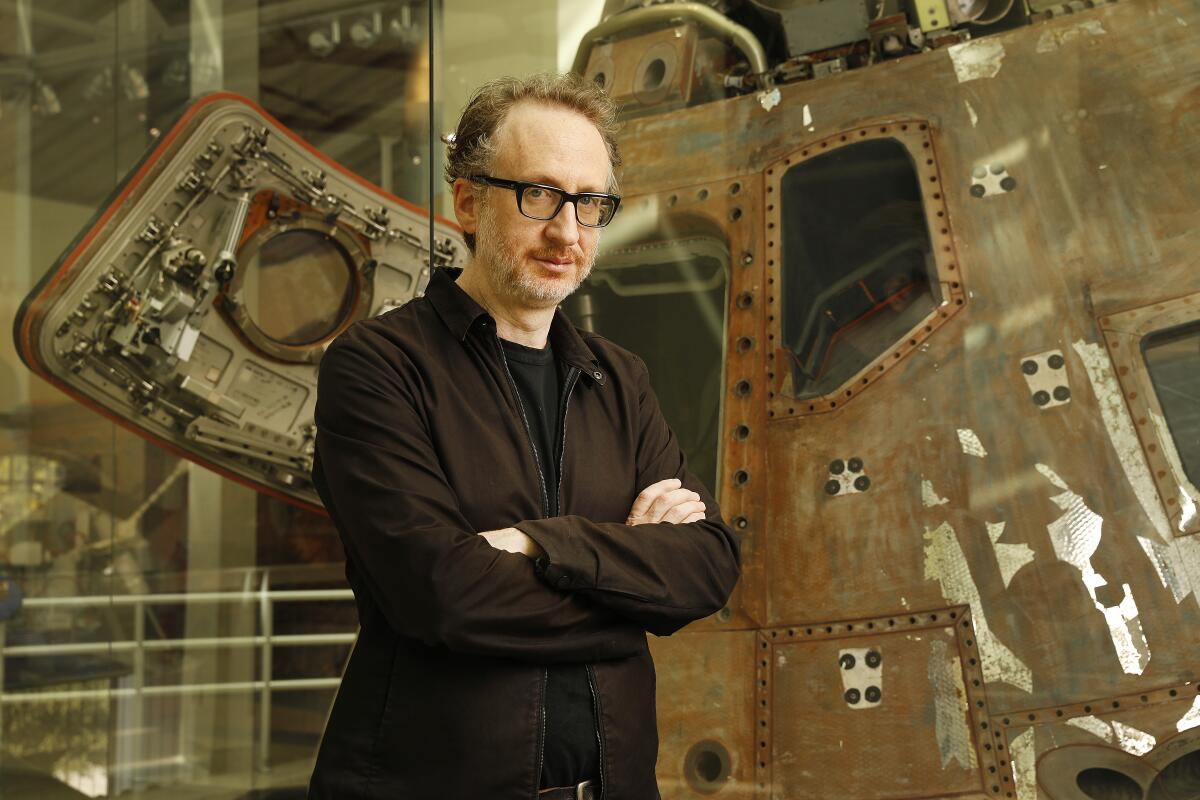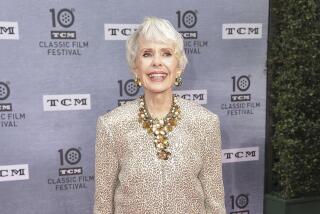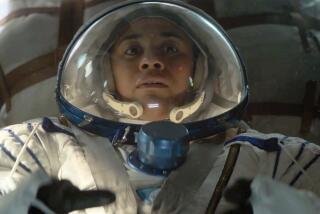How Brad Pitt’s ‘Ad Astra’ survived delays, a tweaked ending and a Disney adoption

The new movie “Ad Astra,” which makes its world premiere today at the Venice Film Festival, is a delicate balancing act — a science-fiction action-adventure epic on the one hand, and a quiet, ruminative treatise on masculinity and the necessity of human connection on the other.
Directed, co-produced and co-written by James Gray, the film stars Brad Pitt as Roy McBride, an American astronaut sent on a top-secret mission to discover the source of destructive power surges coming from deep space. Roy’s father, an astronaut played by Tommy Lee Jones who disappeared while on a space exploration mission many years earlier, is believed to be hiding in orbit somewhere near Neptune and could hold the answer.
The movie’s dazzling, energetic action sequences include a lunar rover chase on the moon, McBride breaking into a rocket as it prepares to launch from Mars and later hurtling through open space. All while tracking McBride’s interior journey as a man living a life of isolation and solitude, coming to the realization he needs more.
“In a sense, the truly unknown, the true terra incognita is the landscape of the human soul,” said Gray during a recent interview in Los Angeles. “And sometimes instead of looking outward, look inward. To keep looking outward, it doesn’t really give you answers.
“There’s a quote by Arthur C. Clarke where he said either we’re not alone in the universe or we are and both notions are equally terrifying. So all of this went into the movie and the action beats really were an attempt only to illuminate and expand upon these ideas.”
The heady mix isn’t exactly unfamiliar in the sci-fi genre — films ranging from “2001: A Space Odyssey” to the more recent “Gravity” and “Interstellar” have pitted humans’ exploration of the universe against an exploration of the soul. But it’s still rarefied air for a major studio film in a landscape increasingly dominated by franchises. And bringing “Ad Astra” to the screen was no walk in the stars.
Post-production delays, multiple release date changes and the monumental acquisition of 21st Century Fox by the Walt Disney Co. have led to a series of questions and concerns about the film and how it will be received. (Or, at one perilous point earlier this summer, if it would ever be received at all.)
Production on “Ad Astra” wrapped late in 2017, after which Gray entered into a long post-production process. The movie was slated to be released in January, with speculation it could factor into the 2018 Oscar race with an awards-qualifying run, but was then moved to May, with many expecting it to premiere at the Cannes Film Festival considering Gray’s international festival circuit track record.
But as the release date loomed and no trailer or marketing materials had surfaced, Disney announced a new release date a little less than three weeks before it was scheduled to hit theaters.
That date — Sept. 20 — stuck and the Venice bow was announced in late July.
“I won’t lie to you, it’s strange that you make this adult-oriented science fiction epic and it’s the Disney corporation that’s releasing it,” Gray said. “But having said that, they’ve been fantastic. They love the film, they’ve been really embracing of it.
“What people don’t understand when they ask, ‘Where’s your movie?,’ it’s like, my movie is a pimple on the ass of a $71-billion deal between two behemoths. And I don’t think people get that really,” said Gray. “I mean, that is a weird circumstance. It just is.”
Pitt and producing partners Dede Gardner and Jeremy Kleiner at his production company Plan B, who won best picture Oscars for “12 Years A Slave” and “Moonlight,” previously worked with Gray on “The Lost City of Z.” (Pitt was for a time attached to star, in a role eventually played by Charlie Hunnam.)
The company’s titles include “World War Z” and “The Tree of Life,” both of which also starred Pitt and faced delays and revisions on their way to being finished, leading Kleiner to declare post-production on “Ad Astra” as “par for the course.”
I don’t spend any time on that. Each film is its own beast and to get all the tumblers in line and open the lock, it takes what it takes.
— Brad Pitt, on the release date delays of “Ad Astra”
For his part, Pitt feels that any delays in finishing the film and seeing it released were just part of the process.
“I don’t spend any time on that. Each film is its own beast and to get all the tumblers in line and open the lock, it takes what it takes,” said Pitt. “So yes, we love the story if a film’s in trouble. I would say it was the most challenging film I have ever embarked on. I learned something from this one. And I know James did too.”
Working with “Interstellar” cinematographer Hoyte Van Hoytema, “All That Jazz” costume designer Albert Wolsky and returning production designer Kevin Thompson, “Ad Astra” saw Gray making a tremendous step up in budget, to around $80 million before tax breaks, plus dealing with a level of visual effects work that was new to him.
Brad Pitt addresses the mystery surrounding Cliff Booth and his late wife in Quentin Tarantino’s portrait of late-1960s Hollywood and masculinity.
“You know, I have a lot of flaws and one of them is that I miscalculate degree of difficulty,” Gray said. “The jungle [for ‘The Lost City of Z’] was really terrible and very difficult physically. But I thought mistakenly that I was going to go into a soundstage and I would be in L.A. and it would be easier. And it was harder. It was harder than the jungle because you have to create the entire world. You can’t just look for a shot, point the camera. Everything has to be imagined.”
The production of “Ad Astra” at times demanded creating both horizontal and vertical versions of the same sets to portray the effects of zero gravity. Filming also took place at a surprising number of practical locations around Los Angeles County, including a former Times printing facility. Yet despite its increased budget and sci-fi scale, “Ad Astra” feels of a piece with Gray’s previous work, including the critically acclaimed indie dramas “Two Lovers” and “The Immigrant.”
“I think it’s not a thematic leap,” Gardner said of backing Gray’s vision for the film. “And so to me that’s the thing to protect for above all else. There can be more days or bigger equipment or more money, but if you’re in someone’s emotional slipstream, you feel safe regardless of scale. I think we were always from the beginning interested in the physical stakes matching the emotional stakes.”

For Pitt, those emotional stakes, McBride’s glacial stoicism slowly melting away, provided an opportunity for personal reflection as well.
“James and I were both on the same investigation. I certainly grew up in an era of, you know, men show strength. You don’t show weakness. We are capable in all situations,” Pitt said. “And there is a strength in that, but also what comes with that is an inability to take a personal inventory on oneself.
“And so we were asking the question, what’s the real value of living? Why do this? Why go on? And that is human connection. That is friends and family. And so also what is the definition of a man? Could it be that our true strength comes from a vulnerability? Could it be that confidence, true confidence comes from totally embracing our individual weaknesses and being quite open with that?”
I can’t believe I’m going to say this, but Pitt is kind of an underrated actor. On a technical level, underrated. And it’s a pleasure to work with someone like that.
— Director James Gray on “Ad Astra” star Brad Pitt
Even though Gray and Pitt have known each other for many years, this is the first time they have worked together as director and actor. Before shooting began, Gray reached out to filmmaker David Fincher, who directed Pitt in “Seven,” “Fight Club” and “The Curious Case of Benjamin Button,” to ask what it was like directing the Oscar-nominated star.
“He is an unbelievably subtle actor in a way that I didn’t even anticipate,” Gray said. “And he’s extremely intelligent, very shrewd, understands human behavior very well. In some sense, I can’t believe I’m going to say this, but Pitt is kind of an underrated actor. On a technical level, underrated. And it’s a pleasure to work with someone like that.
“The expression is he can fill it up, which means you give him some tidbits and he does the work,” Gray said. “He thinks about it, you roll the camera, all of a sudden you can see the inner workings, the turmoil. It’s, I think, an incredible performance. It’s not showy at all. I have no idea what the world will think, but it is for my money great work.”
Although the cast of “Ad Astra” also includes Ruth Negga, Donald Sutherland, Liv Tyler, John Ortiz, Kimberly Elise and Natasha Lyonne, much of the movie finds Pitt on his own, moving from location to location in his search for his father, giving the film an austere, taciturn air. Gray acknowledged that the story has built-in “whammos” (his word) — action beats to keep the audience invigorated and invested.
“You can’t make an Ingmar Bergman movie. You have to embrace what an audience will need as red meat, as a sugarcoating of the pill,” Gray said. “And so you ask yourself, is it worth it to express yourself on this scale, but include red meat and some sugarcoated pill for the audience, or to say ‘No, no, I have no interest in communicating anything but precisely what it is I’m after,’ in which case, good, you’ve got no movie. And I would rather have a movie.”
One aspect of “Ad Astra” altered from Gray’s original conception is the film’s ending, which concludes with a scene shot earlier this year.
I certainly felt that I had already pushed the envelope on the film, that in the current climate of movies that we had been as bold as we could be.
— “Ad Astra” director James Gray
“I certainly felt that I had already pushed the envelope on the film, that in the current climate of movies that we had been as bold as we could be,” Gray said. “And if this was a compromise that I had to make, then I was willing to do it to get the film out there. I mean, that’s just as honest and straightforward as I can be about it.”
“I don’t see it as a change, I see it as evolved,” said Pitt of the new ending. “From the beginning when we started with the script, the basic structure was there, the architecture of ‘we’re going to go to the moon, then we’re going to go to Mars and then we’re going to go to Neptune.’ But so much of it has constantly been in flux, I don’t see that as change. I see that as a natural part of its growth.”
Through it all, Gray still sees the final result as the film he wanted to make. Much as the character of McBride comes to learn that he needs other people after all, in making “Ad Astra” Gray gained a newfound appreciation for compromise and collaboration.
“It’s about what it is that I had wanted it to be about,” said Gray. “There are compromises that you have to make along the way, invariably. And it’s a collaboration, invariably, on this size movie. Even the simple movie of two goofballs in a room, it’s like a wild horse. Always going to get away from you.
“The job of the director and the challenge of the writer-director is not to try to corral the horse and make sure that you can keep your reins. Because that’s never going to happen. Your job is to embrace the things that make it look more beautiful as it gets away from you and try and eliminate the things that might affect the beauty of the horse running away from you. It’s going to get out of your control. But that’s OK.”
More to Read
Only good movies
Get the Indie Focus newsletter, Mark Olsen's weekly guide to the world of cinema.
You may occasionally receive promotional content from the Los Angeles Times.







